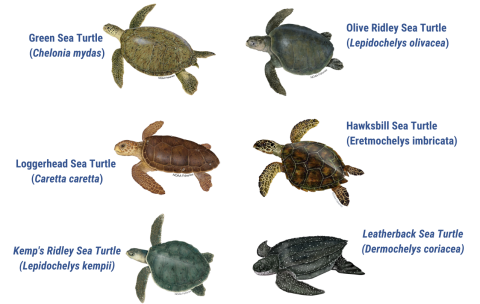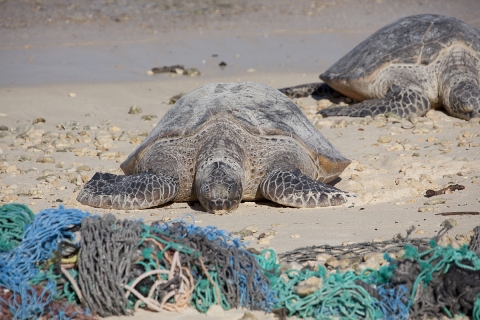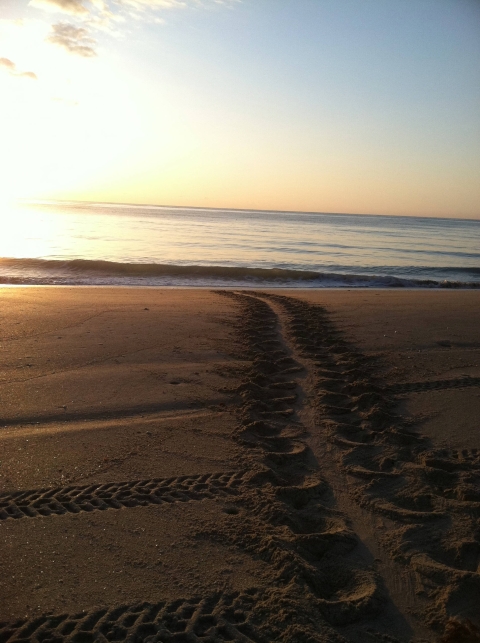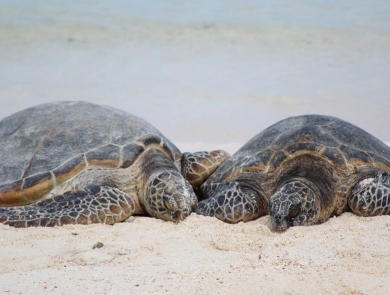What We Do
Our Projects and Initiatives
Through the Marine Turtle Conservation Fund (MTCF), we provide technical and financial assistance and international conservation leadership to protect and recover these important animals around the world.
Sea Turtle Species
Sea turtles are keystone species. This means their presence is instrumental to the survival of many other species in their environment. Declines in sea turtles can have a negative impact on other species and entire ecosystems.
Of the seven species of sea turtles, six are found in U.S. waters and protected under the Endangered Species Act. Three species are so imperiled that they are listed as critically endangered.
All seven species, including the flatback sea turtle, which is not found in U.S. waters, are included in Appendix I of CITES, its highest level of international trade protection, under which no commercial trade is allowed.
The Importance of Healthy Sea Turtle Populations
Sea turtles play a critical role in maintaining healthy coral reefs, sea grass beds, and beaches, all of which are important to humans.
For example, green sea turtles graze on seagrass and play a critical role in maintaining healthy seagrass meadows. These meadows provide many vital ecosystem services that contribute to healthy oceans, including water quality protection, erosion control, carbon storage, support for biodiversity, and fisheries production. Hawksbill sea turtles promote the growth of coral reefs by dispersing coral larvae and control overgrowth of sponges to maintain a balanced and delicate ecosystem.
The desire to see adult sea turtle, nesting sea turtles, and hatchings also benefits U.S. communities. For example, organized turtle walks support local economies.
Healthy oceans, bolstered by healthy sea turtle populations, ultimately support human health around the world by regulating climate and providing water and food resources. Conserving them is important for both the environment and humans.
Threats to Sea Turtle Survival
Sea turtles represent one of the most imperiled animal groups on Earth. They have a complex life cycle, and their stages of development (egg, hatchling, juvenile, and adult) occur across wide-spread and diverse habitats such as beaches, estuaries, lagoons, coral reefs, and open oceans. They spend most of their time in the water, but adult females return to beaches to nest. In each life stage, sea turtles face a number of threats, including the trafficking of sea turtles and eggs, bycatch, and habitat loss. It is estimated that only one in every 1,000 sea turtle hatchlings survive to adulthood.
Wildlife Trafficking
The direct take and illegal trade of sea turtles, eggs, and products continue to be a major threat. Since all sea turtle species are included in Appendix I of CITES, no commercial trade is legal. However, sea turtles are still illegally taken to make products such as hair combs, decorative items, jewelry, and eyeglasses from their shells; leather products from their neck and flippers; and cosmetics and soaps from their fat. Their eggs and meat are also taken and used for human consumption.
Bycatch
Bycatch is the unintentional capture of non-target species in fishing gear. It can occur wherever there is fishing and is a worldwide threat to sea turtle survival. It also threatens the resiliency of fish populations, ocean ecosystems, and coastal communities.
Sea turtles can also become entangled in left-behind fishing nets, or swallow fishing hooks, preventing them from coming up for air or finding food.
Habitat Loss
Habitat loss results in a reduction of suitable nesting habitats, acceleration of beach erosion, and adverse changes in the natural shoreline. Sea level rise, and the increase of storm frequency and intensity, also result in the permanent loss of nesting habitats.
In addition to the above primary threats, each life stage faces additional threats. For example:
- On beaches, eggs, hatchlings, and nesting sea turtles are eaten by predators such as feral dogs and pigs.
- Warmer sand temperatures can cause more female than male hatchlings.
- Environmental hazards such as oil spills, industrial chemical spills, and agricultural pesticide runoff can cause injury or death to sea turtles and destroy their food sources.
- Boat strikes may cause severe injury or death. Sea turtles must come up for air and are difficult for boaters to see in the water.
- Plastic trash is especially dangerous and is not biodegradable. To adult sea turtles, floating plastic bags may look like food, such as jellyfish. Once ingested, plastics can cause an extremely painful death.
Congressional Action
In 2004, Congress responded to the decline of sea turtles by enacting the Marine Turtle Conservation Act . Its purpose is, “to assist in the conservation of marine turtles and the nesting habitats of marine turtles in foreign countries by supporting and providing financial resources for projects to conserve the nesting habitats, conserve marine turtles in those habitats, and address other threats to the survival of marine turtles.”
In the Act, Congress wrote:
- Marine turtle populations have declined to the point that their long-term survival in the wild is in serious jeopardy;
- The challenges facing marine turtles are immense, and the resources available have not been sufficient to cope with the continued loss of nesting habitats caused by human activities and the consequent diminution of marine turtle populations;
- Because marine turtles are long-lived, late-maturing, and highly migratory, marine turtles are particularly vulnerable to the impacts of human exploitation and habitat loss;
- Illegal international trade seriously threatens wild populations of some marine turtle species, particularly the hawksbill turtle;
- Because marine turtles are flagship species for the ecosystems in which marine turtles are found, sustaining healthy populations of marine turtles provides benefits to many other species of wildlife, including many other threatened or endangered species;
- Marine turtles are important components of the ecosystems that they inhabit, and studies of wild populations of marine turtles have provided important biological insights;
- Changes in marine turtle populations are most reliably indicated by changes in the numbers of nests and nesting females;
- The reduction, removal, or other effective addressing of the threats to the long-term viability of populations of marine turtles will require the joint commitment and effort of
- countries that have within their boundaries marine turtle nesting habitats; and
- persons with expertise in the conservation of marine turtles.
Conservation Efforts
We work closely with National Oceanic and Atmospheric Administration (NOAA) Fisheries on international sea turtle conservation by sharing technical information and managing complementary conservation efforts on the ground. Domestically, we lead sea turtle conservation efforts on nesting beaches, and NOAA leads conservation and recovery efforts at sea. In international waters, we work with partners through the MTCF to support sea turtle conservation projects around the world.
The protection and recovery of sea turtles is a long-term endeavor because of their complex biology and the numerous threats they face. Projects supported by the MTCF are guided by scientifically-sound, core conservation principles. Key strategies include protecting nesting; developing local capacity for turtle conservation and management; facilitating conservation education and community outreach; strengthening habitat protection and management; and promoting regional and international networks, partnerships, and coalitions.
Specifically, our MTCF supports work that:
- Protects nesting by reducing threats from poaching, predation, and pollution (artificial lights and obstructions).
- Monitors nesting to alert relevant entities for more urgent or expanded attention to threats and sites where there is a declining trend in nesting.
- Reduces threats in coastal waters through bycatch assessments, gear testing, and incorporation of gear modification and fishing practices to protect sea turtles.
- Strengthens engagement with local and indigenous communities, local and national NGOs, government authorities, and other relevant stakeholders to promote sea turtle conservation.
- Collaborates and shares information between projects and with individuals, programs, and community; government and regional authorities; and institutions.
- Increases the number of local champions for sea turtle conservation.
By working with partners across international boundaries, we help ensure that sea turtle populations are stable and that those born here safely return to U.S. beaches to lay their eggs, help balance and benefit our ecosystems, and be present for future generations to enjoy.
Success Stories: Working with Local Communities towards Species Recovery
We have a proven track record of leadership and success that provide hope for recovery efforts. Across the world, we have funded projects and research that have impressive results. Two examples include our projects supporting loggerhead sea turtles in Cape Verde and hawksbills sea turtles in Panama.
Since 2009, our support in Cape Verde (an archipelago and island country in the central Atlantic Ocean) has helped decrease loggerhead mortality by 87 percent. It has also supported the formation of the Cape Verde Sea Turtle Partnership that facilitates collaboration among local organizations and Cape Verdean authorities. Projects encompass the most important loggerhead nesting beaches on the islands of Boa Vista, Sal, and Maio, which harbor about 95 percent of nesting within Cape Verde.
Another success story is a hawksbill project in Panama, where our support has led to a 350 percent increase of nests. At one time, Chiriqui and surrounding beaches were home to the largest hawksbill nesting population in the Caribbean, but due to the high demand for tortoiseshell products in the 1970s and 1980s, hawksbills were killed at a massive rate. In 2003, we began funding efforts to recover this species. At the beginning of the project, fewer than 400 hawksbill nests were recorded on Chiriqui Beach. After years of our support to conserve hawksbills in this area, and by working closely with the local Ngabe communities, thousands of hawksbill nests have been recorded. Nesting trends are positive, and the population is steadily recovering.
Notice of Funding Opportunity
These successes are the direct result of grants provided by the MCTF. Applications for our Notice of Funding Opportunity (NOFO) must be submitted via GrantSolutions.gov .
One of the program’s strengths is the long-term, consistent funding we provide for conservation, while promoting constructive engagement for sea turtle protection. We provide a consistent, scientifically-based working model that our partners trust.
You can help conserve sea turtles in multiple ways.
Careers with the U.S. Fish and Wildlife Service
If you would like a career in conservation or volunteer with us, please visit our Careers and Internships web page.









